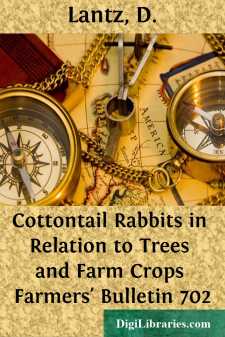Categories
- Antiques & Collectibles 13
- Architecture 36
- Art 48
- Bibles 22
- Biography & Autobiography 813
- Body, Mind & Spirit 142
- Business & Economics 28
- Children's Books 17
- Children's Fiction 14
- Computers 4
- Cooking 94
- Crafts & Hobbies 4
- Drama 346
- Education 46
- Family & Relationships 57
- Fiction 11829
- Games 19
- Gardening 17
- Health & Fitness 34
- History 1377
- House & Home 1
- Humor 147
- Juvenile Fiction 1873
- Juvenile Nonfiction 202
- Language Arts & Disciplines 88
- Law 16
- Literary Collections 686
- Literary Criticism 179
- Mathematics 13
- Medical 41
- Music 40
- Nature 179
- Non-Classifiable 1768
- Performing Arts 7
- Periodicals 1453
- Philosophy 64
- Photography 2
- Poetry 896
- Political Science 203
- Psychology 42
- Reference 154
- Religion 513
- Science 126
- Self-Help 84
- Social Science 81
- Sports & Recreation 34
- Study Aids 3
- Technology & Engineering 59
- Transportation 23
- Travel 463
- True Crime 29
Cottontail Rabbits in Relation to Trees and Farm Crops Farmers' Bulletin 702
by: D. Lantz
Description:
Excerpt
INTRODUCTION.
Among the serious pests in orchards and tree plantations are the several native species of rabbits. These animals do considerable damage to garden truck and other farm crops also, especially on lands recently opened to cultivation. North American rabbits belong to two general classes easily distinguished by their size and habits.
The larger forms include the arctic and varying hares, or snowshoe rabbits, and the jack rabbits, and are found throughout nearly all of Alaska and Canada and in all the States west of the Mississippi except Arkansas and Louisiana. East of the Mississippi they inhabit the northern parts of Minnesota, Wisconsin, and Michigan, most of New York and New England, and southward in the Appalachian Mountains, parts of Pennsylvania, Maryland, and Virginia.
Genus Lepus.
The smaller forms, generally called "cottontail rabbits," occur in every State, but are absent from the greater part of Maine, the northern parts of New Hampshire, Vermont, New York, Michigan, Wisconsin, and Minnesota, and from the western parts of Washington and Oregon. In recent years they have extended their range northward in the New England States, New York, and portions of the West, and have invaded and occupied a considerable part of the Province of Ontario. In habits they differ materially from the larger rabbits. They live in copses and thickets more than in open fields. The young are born blind, naked, and helpless, while those of the larger rabbits have the eyes open, are partially furred, and active when born.
Genus Sylvilagus.
Rabbits of both genera, however, feed exclusively on vegetation, and are at times harmful to crops and especially to trees. Because of their size and great abundance in parts of their range, jack rabbits are by far the most destructive, but, except in a few places where they have been introduced, none are found east of the Mississippi. Epizootics (diseases which attack many animals at the same time) are an effectual natural check, and after such attack occurs, jack rabbits are usually so reduced in numbers that they are not troublesome again for several years.
Traps and other devices that are effective with cottontail rabbits do not always succeed with jack rabbits. The recommendations contained in this bulletin will, therefore, apply only to cottontail rabbits, but they may suggest methods that, with modifications, may be used against the larger forms.
Cottontail rabbits (fig. 1) are so well known that little need be said of their habits. They breed several times each year during the warmer months, the litters averaging five or six young. The nest is usually placed in a hollow or depression of the ground, often in open fields or meadows. It is composed of dead grass and warmly lined with fur which the female pulls from her own body. The male rabbit takes no part in caring for the young, and the female weans them as soon as they are able to leave the nest. These animals breed so rapidly that in spite of many natural enemies, and of the fact that they are hunted for human food, they often become numerous enough to inflict serious losses on farmers and fruit growers in many parts of the United States (fig....


